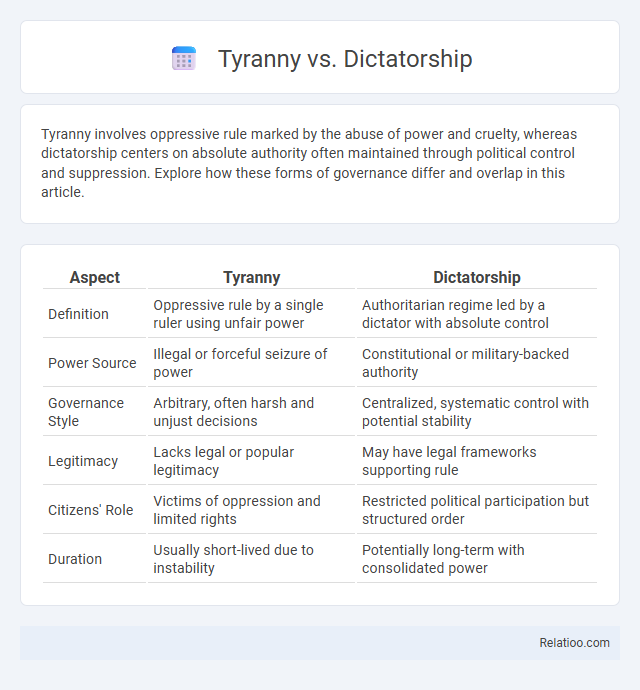Tyranny involves oppressive rule marked by the abuse of power and cruelty, whereas dictatorship centers on absolute authority often maintained through political control and suppression. Explore how these forms of governance differ and overlap in this article.
Table of Comparison
| Aspect | Tyranny | Dictatorship |
|---|---|---|
| Definition | Oppressive rule by a single ruler using unfair power | Authoritarian regime led by a dictator with absolute control |
| Power Source | Illegal or forceful seizure of power | Constitutional or military-backed authority |
| Governance Style | Arbitrary, often harsh and unjust decisions | Centralized, systematic control with potential stability |
| Legitimacy | Lacks legal or popular legitimacy | May have legal frameworks supporting rule |
| Citizens' Role | Victims of oppression and limited rights | Restricted political participation but structured order |
| Duration | Usually short-lived due to instability | Potentially long-term with consolidated power |
Understanding Tyranny: Definition and Origins
Tyranny is a form of oppressive rule where a single authority wields absolute power without legal restraint, often emerging from the collapse of political order or social unrest. Originating from ancient Greek history, the term "tyranny" described rulers who seized power unconstitutionally and governed without regard for justice or the welfare of the people. Your grasp of tyranny helps differentiate it from dictatorship, where power is usually institutionalized, highlighting the nuanced origins and implications of these authoritarian systems.
What is a Dictatorship? Key Characteristics
A dictatorship is an authoritarian form of government where absolute power is concentrated in the hands of a single ruler or a small group, often without constitutional limitations or democratic processes. Key characteristics include centralized control, suppression of political opposition, curtailment of civil liberties, and the absence of free and fair elections. Unlike tyranny, which emphasizes oppressive rule by an individual, dictatorships may vary in scope but consistently involve unchecked authority and limited political pluralism.
Historical Examples of Tyranny
Historical examples of tyranny include the rule of figures like King Nero of ancient Rome, whose oppressive governance led to widespread fear and unrest. Unlike a dictatorship, which often consolidates power through military or political means, tyranny typically involves ruthless and arbitrary use of authority without legal restraints, as seen in the reign of the tyrant Pisistratus in Athens. Understanding these distinctions helps you grasp how tyranny has shaped political systems through history.
Notable Dictatorships in History
Notable dictatorships in history include regimes led by Adolf Hitler in Nazi Germany, Joseph Stalin in the Soviet Union, and Benito Mussolini in Fascist Italy, each characterized by centralized control and suppression of opposition. Tyranny often refers to oppressive rule by a single entity or group, emphasizing unjust power, while dictatorship specifically denotes absolute authority held by one leader, often maintained through force. Understanding your distinction between tyranny and dictatorship helps clarify how these forms of governance impact societies and historical narratives.
Tyranny vs Dictatorship: Core Differences
Tyranny and dictatorship represent forms of authoritarian rule, but tyranny is characterized by oppressive and unjust use of power, often lacking legal legitimacy, whereas dictatorship denotes absolute control by a single ruler or party, sometimes with a structured regime. Your understanding of tyranny involves recognizing arbitrary rule driven by cruelty or unfairness, while dictatorship focuses on the concentration of political authority regardless of governing methods. Core differences hinge on tyranny's emphasis on moral corruption and oppression, contrasting with dictatorship's emphasis on centralized, often institutionalized, political dominance.
Methods of Control: Tyrants vs Dictators
Tyrants often maintain control through arbitrary use of power, relying on fear, intimidation, and manipulation of laws to suppress opposition. Dictators typically employ organized state apparatuses such as secret police, military force, and propaganda to enforce their rule systematically. Both use censorship and surveillance, but dictators' methods are usually more institutionalized and bureaucratic compared to the personalized and unpredictable tactics of tyrants.
Impact on Society and Human Rights
Tyranny, dictatorship, and authoritarianism each severely restrict human rights, but tyranny often involves oppressive rule through fear and arbitrary power, leading to widespread social suffering and injustice. Dictatorships centralize power in a single leader who suppresses dissent and limits freedoms, causing systemic violations of civil liberties and stagnant social progress. Your awareness of these distinctions helps in recognizing how such regimes degrade societal structures and erode essential human rights protections.
Political Structures: Comparing Governance Models
Tyranny, dictatorship, and despotism represent distinct yet overlapping autocratic governance models defined by centralized power and limited political freedoms. A tyranny typically arises when a ruler seizes power illegitimately, often characterized by oppressive rule without legal authority, whereas a dictatorship involves absolute authority concentrated in a single leader or ruling group, frequently maintained through military or political control. Despotism emphasizes arbitrary and often cruel exercise of power, highlighting the ruler's unchecked dominance over political institutions and civil rights, distinguishing it from other autocratic structures by the intensity of authoritarian practices.
Pathways to Tyranny and Dictatorship
Pathways to tyranny often involve the systematic erosion of democratic institutions, where a leader consolidates power by undermining checks and balances, manipulating legal frameworks, and suppressing opposition. In contrast, pathways to dictatorship typically arise through abrupt seizures of power, such as coups or revolutions, where authority is maintained through force and centralized control. Your understanding of these distinctions highlights the importance of vigilance in preserving political freedoms and preventing authoritarian regimes.
Resisting Oppression: Lessons from History
History reveals that tyranny often stems from unchecked dictatorial power leading to widespread oppression, while resisting such regimes requires collective courage and strategic action. Your awareness of past movements, such as the French Revolution or the fall of Nazi Germany, highlights effective tactics like mass protests, underground networks, and international solidarity. Understanding these lessons arms you with knowledge to identify and oppose authoritarianism before it escalates into full-blown tyranny.

Infographic: Tyranny vs Dictatorship
 relatioo.com
relatioo.com